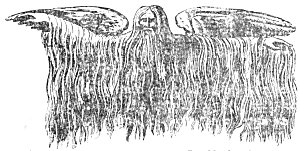Hermes calls the Zodiac, the Great Tent,–Tabernaculum. In the Royal Arch Degree of the American Rite, the Tabernacle has four veils, of different colors, to each of which belongs a banner. The colors of the four are White, Blue, Crimson, and Purple, and the banners bear the images of the Bull, the Lion, the Man, and the Eagle, the Constellations answering 2500 years before our era to the Equinoctial and Solstitial points: to which belong four stars, Aldebarán, Regulus, Fomalhaut, and Antares. At each of these veils there are three words: and to each division of the Zodiac, belonging to each of these Stars, are three Signs. The four signs, Taurus, Leo, Scorpio, and Aquarius, were termed the fixed signs, and are appropriately assigned to the four veils.
So the Cherubim, according to Clemens and Philo, represented the two hemispheres their wings, the rapid course of the firmament, and of time which revolves in the Zodiac. “For the Heavens
p. 410
fly;” says Philo, speaking of the wings of the Cherubim: which were winged representations of the Lion, the Bull, the Eagle, and the Man; of two of which, the human-headed, winged bulls and lions, so many have been found at Nimroud; adopted as beneficent symbols, when the Sun entered Taurus at the Vernal Equinox and Leo at the Summer Solstice: and when, also, he entered Scorpio, for which, on account of its malignant influences, Aquilla, the eagle was substituted, at the autumnal equinox; and Aquarius (the water-bearer) at the Winter Solstice.
So, Clemens says, the candlestick with seven branches represented the seven planets, like which the seven branches were arranged and regulated, preserving that musical proportion and system of harmony of which the sun was the centre and connection. They were arranged, says Philo, by threes, like the planets above and those below the sun; between which two groups was the branch that represented him, the mediator or moderator of the celestial harmony. He is, in fact, the fourth in the musical scale, as Philo remarks, and Martianus Capella in his hymn to the Sun.
Near the candlestick were other emblems representing the heavens, earth, and the vegetative matter out of whose bosom the vapors arise. The whole temple was an abridged image of the world. There were candlesticks with four branches, symbols of the elements and the seasons; with twelve, symbols of the signs; and even with three hundred and sixty, the number of days in the year, without the supplementary days. Imitating the famous Temple of Tyre, where were the great columns consecrated to the winds and fire, the Tyrian artist placed two columns of bronze at the entrance of the porch of the temple. The hemispherical brazen sea, supported by four groups of bulls, of three each, looking to the four cardinal points of the compass, represented the bull of the Vernal Equinox, and at Tyre were consecrated to Astarte; to whom Hiram, Josephus says, had builded a temple, and who wore on her head a helmet bearing the image of a bull. And the throne of Solomon, with bulls adorning its arms, and supported on lions, like those of Horus in Egypt and of the Sun at Tyre; likewise referred to the Vernal Equinox and Summer Solstice.
Those who in Thrace adored the sun, under the name of Saba-Zeus, the Grecian Bakchos, builded to him, says Macrobius, a temple on Mount Zelmisso, its round form representing the world and the sun. A circular aperture in the roof admitted the light,
p. 411
and introduced the image of the sun into the body of the sanctuary, where he seemed to blaze as in the heights of Heaven, and to dissipate the darkness within that temple which was a representative symbol of the world. There the passion, death, and resurrection of Bakchos were represented.
So the Temple of Eleusis was lighted by a window in the roof. The sanctuary so lighted, Dion compares to the Universe, from which he says it differed in size alone; and in it the great lights of nature played a great part and were mystically represented. The images of the Sun, Moon, and Mercury were represented there, (the latter the same as Anubis who accompanied Isis); and they are still the three lights of a Masonic Lodge; except that for Mercury, the Master of the Lodge has been absurdly substituted.

Moe is the founder of GnosticWarrior.com. He is a father, husband, author, martial arts black belt, and an expert in Gnosticism, the occult, and esotericism.





